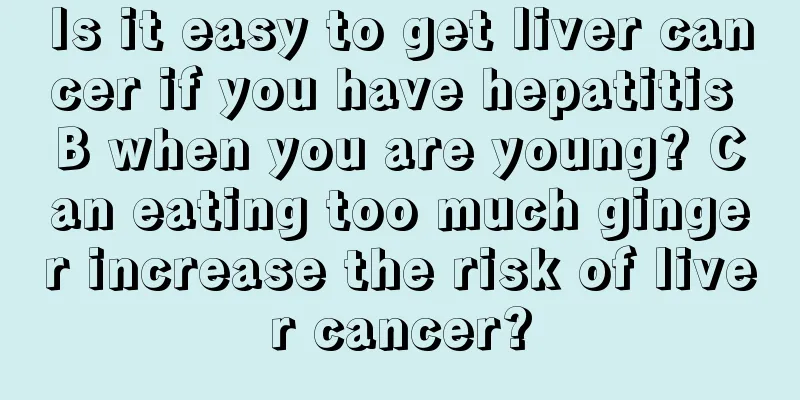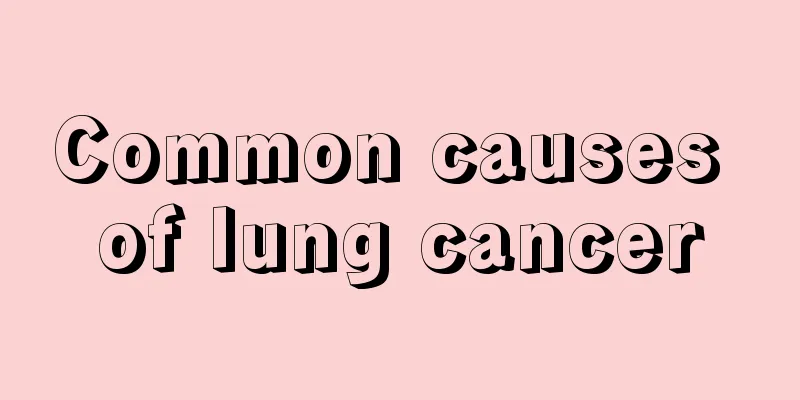How should rectal cancer be treated with chemotherapy

|
With the progress of the times, people's living standards are getting higher and higher. While you are enjoying life with your family, have you ever thought about paying attention to some cancers? Although modern technology is advanced, due to the hidden nature of rectal cancer, the symptoms of early cancer patients are extremely unclear. Clinically, most patients with rectal cancer have obvious symptoms in the middle and late stages. Here, we remind our friends that even if you are not sick, you should pay attention to it. Even if you don't consider yourself, you should consider your family. The health of your family is your own health. 1. Intravenous chemotherapy Intravenous chemotherapy is chemotherapy administered through a peripheral vein. It began in the 1940s and was used in the 1950s as an adjuvant therapy before and after tumor surgery. Early adjuvant chemotherapy for rectal cancer was mainly based on 5-FU alone. After the 1970s, with the continuous development of clinical research, a relatively mature postoperative chemotherapy regimen has gradually emerged. Due to the toxic and side effects of chemotherapy, preoperative chemotherapy is still mostly based on a single small amount of medication. Commonly used drugs include 5-FU, MMC, ADM, DDP, CTX, etc., triple or quadruple drugs, and the dosage varies due to individual differences. For adults, it is generally 5-FU1.5~2.5g, MMC10~30mg, ADM40~60mg, DDP60~120mg, CTX600~800mg. The efficacy of intravenous chemotherapy has been reported differently, and most of them are based on the effectiveness. According to the in vitro short-term drug sensitivity study report of human colorectal cancer, the effectiveness of commonly used drugs is 82.9% for MMC, 81.3% for 5-FU, 68.8% for ADM, and 56.3% for DDP. The results of basic research in recent years have shown that the efficacy of intravenous chemotherapy for rectal cancer is not satisfactory. Riva et al.'s research and development on the treatment of gastrointestinal cancer showed that the drug content reaching the tumor tissue through peripheral intravenous medication is extremely limited. The absolute dose of chemotherapy drugs in each gram of tumor tissue is only 0.0007% to 0.01% of the injection dose, and its effectiveness is only 10% to 20%. Shan Licheng used 5-FU intravenous chemotherapy for 11 patients with rectal cancer before surgery, 0.75g per day, a total of 6 to 9g. After surgery, the cell morphology and ultrastructure of the resected specimens were observed and found that there was no obvious degeneration, dissolution, or necrosis of the cancer cells after intravenous chemotherapy. The author believes that intravenous chemotherapy is not effective for middle and late stage rectal cancer. The drug concentration in the peripheral blood of intravenous chemotherapy is high, the toxic side effects are simple, no special equipment is required, and it is easy to implement. It is still in clinical application. In order to improve the efficacy, it is still necessary to continuously study and improve the medication regimen, dosage, dosage form, method, time, etc. 2. Intestinal chemotherapy Enteral chemotherapy is a drug administered through the anorectal cavity, which is absorbed into the tissue through the rectal wall mucosa to achieve the therapeutic purpose. Enteral chemotherapy is mostly used as a single drug of 5-FU emulsion or suppository. The administration method is simple. The drug is placed into the rectal cavity through the anus and kept in the rectum for more than 3 hours in a supine position, twice a day, with a total administration of 5 to 10 g. The operation is performed after resting for 1 to 2 days. In 1960, Rousselet et al. first reported the use of enteral chemotherapy as an adjuvant treatment for colorectal cancer surgery, and enteral chemotherapy has gradually attracted people's attention. Due to the unsatisfactory efficacy of intravenous chemotherapy and serious toxic side effects, in order to seek a better route of medication, more attention has been paid to the study of enteral chemotherapy in recent years. Studies on rabbits with isotope-labeled 5-FU found that after rectal administration, the concentration of 5-FU in the rectal wall and draining lymph nodes was much higher than that of intravenous drugs. On this basis, the authors conducted a study on the morphology and ultrastructure of cancer cells after administration through both the enteral and intravenous routes. For those who were administered through the enteral cavity, a suppository or emulsion containing 200 mg of 5-FU was applied through the anorectal cavity each time, once in the morning and evening, until 1 day before surgery, with a total administration of 6750 mg. The results showed that 40% and 45% of the cancer cells had obvious destruction of morphology, and 47.5% and 50.0% of the cancer cells had obvious degenerative changes in ultrastructure, respectively. For intravenous administration, 5-FU was intravenously dripped for 5 consecutive days before surgery, 30 mg/kg per day, and surgery was performed 5 days later. The results showed that there was no obvious change or damage in the morphology and ultrastructure of cancer cells. The author believes that intravenous chemotherapy is not suitable for rectal cancer before surgery, and transrectal administration is the best way. In order to further improve the efficacy, Lv Junji and others used a special two-cavity one-balloon tube for intestinal cavity permeation chemotherapy. The drug bag was a semipermeable membrane that completely covered the tumor. The capsule contained 2.5% 5-FU solution and the pressure inside the capsule was 10kpa. Because the capsule contains a positive pressure hypotonic solution, the solution is easy to penetrate and absorb into the tumor tissue, thereby improving the efficacy. Through clinical observation of 86 cases, the local recurrence rate was reduced by 22% compared with the control group without chemotherapy. Although enteral chemotherapy has achieved certain therapeutic effects, it still has a high rate of local pelvic recurrence after surgery. Wang Yichun conducted clinical observations on 100 cases and found that the recurrence rate was 15%. After Lv Junji and others used enteral permeation chemotherapy, there were no significant changes in the ultrastructure of cancer cells and nuclear DNA synthesis. Liu Baochi and others' clinical observations showed that enteral chemotherapy is effective for patients with small tumors. For patients with a straight length of less than 2 cm, the tumor shrinks significantly after enteral chemotherapy. The effect is poor for patients with a wider range of tumor infiltration. This may be because the absorption and penetration capacity of enteral chemotherapy drugs is limited and it is difficult to enter deeper tissues. Postoperative pelvic recurrence is often a lesion that is deep and difficult to remove surgically. 3. Arterial chemotherapy Since arterial blood flows through tissue capillaries and enters the systemic circulation, transarterial medication can be used not only for water-soluble drug perfusion, but also for embolization with embolic agents. Arterial catheterization therapy for tumors began in the 1960s. In 1962, Newtom first successfully used arterial catheterization and embolization to treat spinal hemangioma. In the late 1970s, arterial catheterization therapy for tumors was gradually widely used and continuously developed, and has now become an indispensable method for tumor treatment. Arterial catheterization chemotherapy for rectal cancer is mostly used in the late stage or postoperative recurrence. Arterial catheterization chemotherapy to prevent pelvic recurrence after radical resection of rectal cancer includes percutaneous femoral artery puncture of the internal iliac artery or inferior mesenteric artery catheterization chemotherapy, and intraoperative internal iliac artery ligation catheterization chemotherapy. The perfusion drugs are usually 5-FU and MMC, and the triple or quadruple drugs are used once. The medication regimen and dosage are the same as intravenous chemotherapy. Iodized oil, gelatin sponge, and anticancer agent microparticle capsules are often used for embolization therapy. Iodized oil and gelatin sponge are mixed with chemotherapy drugs in equal proportions and used. After embolization, they remain in the tumor tissue, and the chemotherapy drugs are slowly released to take effect. Embolization of the inferior mesenteric artery should be carried out with caution to prevent intestinal necrosis and perforation. Iodized oil is generally used, and other embolic agents should not be used for embolization therapy. To explore the best route of chemotherapy for pelvic malignant tumors, 17 cases of gynecological malignancies were treated with 100 mg of cisplatin by different routes. The platinum content in pelvic tumor tissue and peripheral venous blood after medication was determined by atomic absorption spectrometry. Results In the percutaneous femoral artery puncture and internal iliac artery catheterization chemotherapy group, the platinum content in pelvic tumor tissue was 9.93 μg/ml, and the platinum content in peripheral venous blood was 0.009 μg/ml. In the intravenous chemotherapy group, the platinum content in pelvic tumor tissue was 1.11 μg/ml, and the platinum content in peripheral venous blood was 0.95 μg/ml. The platinum content in the pelvic tumor group in the arterial chemotherapy group was 8.94 times that in the intravenous chemotherapy group. Arterial chemotherapy accurately locates the lesions, and the chemotherapy drugs are concentrated in the pelvic tissue, which greatly increases the drug concentration in the local tissue. This is an important factor in improving the efficacy. Arterial chemotherapy drugs diffuse fully and widely in the pelvic tissue. The addition of embolization therapy can cause tumor blood vessels to be occluded and ischemic, and the drug residence time is prolonged, which is conducive to improving the efficacy: the chemotherapy efficacy of solid tumors depends on the concentration of the drug reaching the tumor tissue and the time for the drug to act with the tumor tissue. Although arterial chemotherapy can increase the drug concentration in the pelvic tissue, the blood flow rate is fast, and the drug stays in the tumor tissue and acts on the tumor tissue for a short time. Even with embolization therapy, the effect of keeping the drug in the local tissue is not great. Therefore, the significant improvement of the effect of arterial chemotherapy is still limited. The implementation of arterial chemotherapy requires certain equipment and operation techniques, and the treatment cost is high. It has not been widely used in clinical practice, and there are no systematic reports on the efficacy of preventing pelvic recurrence after radical resection of rectal cancer. Since there are abundant communicating branches between the pelvic organs and the pelvic wall, permanent ligation of the bilateral internal iliac arteries during the Miles operation will not cause ischemic necrosis and dysfunction of the pelvic organs. Therefore, some people perform bilateral ligation of the internal iliac arteries during the Miles operation, catheterize the distal arteries, and perform transcatheter chemotherapy 2 weeks after the operation. It is reported that 45 minutes after the ligation of the internal iliac artery, vascular contrast agent development can be seen at the distal end of the ligature, indicating that an effective collateral circulation has begun to be established. The establishment of collateral circulation may prevent the drug infused from the catheter from diffusing against the collateral blood flow, leaving a "dead corner" that the drug cannot reach and affecting the efficacy. Therefore, its efficacy may be worse than arterial chemotherapy without ligating the artery. In summary, chemotherapy can be used to prevent pelvic recurrence after radical surgery for rectal cancer. For patients with small tumors, tumor diameter less than 4 cm, and shallow lesions, enteral chemotherapy can be used. For patients with large tumors and deep infiltration, percutaneous femoral artery puncture, internal iliac artery or inferior mesenteric artery catheterization embolization perfusion chemotherapy can be used if conditions permit, and intravenous chemotherapy can be used if conditions do not permit. In order to significantly improve the efficacy of chemotherapy, the drug concentration in the pelvic tissue must be increased, fully diffused, and retained for a long time, but this is an issue that needs further exploration. The above is an introduction to "What chemotherapy options are there for rectal cancer?" When the above symptoms appear, patients should go to a regular hospital for treatment. Early detection and early treatment can effectively cure rectal cancer. People who are related to the pathogenic factors of rectal cancer are advised to take preventive measures for rectal cancer. If you have other questions about rectal cancer, please consult our experts online or call for consultation. |
<<: How to care after rectal cancer surgery
>>: What are the tests for esophageal cancer?
Recommend
Liver cancer patients must pay attention to its common symptoms
Liver cancer is a relatively common tumor disease...
If your right eyelid twitches, good things are about to happen
The twitching of the right eyelid seems to indica...
What should I do if I swallow bayberry seeds?
Many people like to eat bayberry. Although bayber...
Is it okay to take protein every day in the late stage of pancreatic cancer?
Albumin refers to human albumin injection. It is ...
Muscle contraction ability refers to
The ability of muscles to contract is relatively ...
How much is the cost of infusion for gallbladder cancer
How much does it cost to infuse gallbladder cance...
Does sweet potato cause internal heat?
Everyone is very familiar with sweet potatoes. Sw...
How to use mothballs
In life, people have a lot of clothes, especially...
What harm does phosphorus do to the body
Speaking of phosphorus, we all know that it is a ...
What is the cause of moderate spleen enlargement
Nowadays, many middle-aged people always have bee...
Can I drink chicken soup if I have a bad stomach?
Many people have certain stomach health problems ...
Can bone cancer be detected early?
In daily life, we need to pay attention to change...
What should I do if there are a lot of cockroaches at home
Cockroaches are a particularly common insect in o...
Why does thyroid cancer not affect life expectancy
Thyroid cancer is a common cancer. Surgery for th...
What are the symptoms of early liver cancer? Teach you how to identify the early symptoms of liver cancer
The main group of liver cancer patients are men. ...









